Router Emulation - Reproducing a PoC of a CVE through ASUS Firmware Emulation
Embedded devices and the IoT ecosystem are becoming more prevalent in everyday life each year, and, as a result, increasingly relevant in IT security. Before AI, before the Metaverse, and even before Blockchain protocols, the most discussed topic in the IT world was smart devices and IoT. We could say that all the aforementioned technologies could become increasingly interconnected in the not-too-distant future. Without delving into pros and cons or positive and negative aspects, but speaking objectively, it all seems very interesting.
In this blog, we will demonstrate how to emulate part of the firmware of ASUS routers in order to replicate the vulnerabilities CVE-2020-36109 and CVE-2023-35086.
Start
In this section, we provide an overview of Embedded Devices, QEMU, and GDB. To jump directly to the CVE emulation section, click here: CVE-2020-36109.
Embedded Devices
Embedded systems running Linux differ from regular PCs primarily in their hardware, which is specific to a particular domain and relies on sensors and actuators. The trade-off between cost and performance is much more critical compared to PCs, which is why memory and CPU resources tend to be more limited. Because of the specific hardware, manufacturer-specific driver modules and user-level software are required to communicate with the system. The solution is to provide firmware along with the device, which is a compressed file containing the kernel and filesystem files. The kernel can be Linux-based or another OS. The format of the compressed file depends on the vendor and may also be encrypted.
Essentially, for a Linux-based embedded device, the boot process follows similar steps to those of a regular PC.
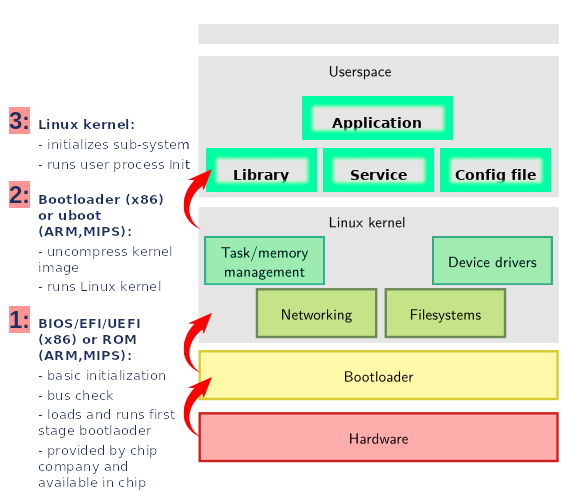
QEMU and GDB
QEMU is an emulator that allows emulation of the CPU and hardware via software, enabling an operating system to be emulated as if it were a regular application. QEMU supports various CPU architectures (ISAs), including Intel x86, ARM, and MIPS.
QEMU offers the following emulation modes:
- QEMU system emulation: Full operating system emulation.

- QEMU system emulation with KVM: Operating system emulation without ISA translation, meaning the guest machine’s ISA must match the host CPU’s ISA.
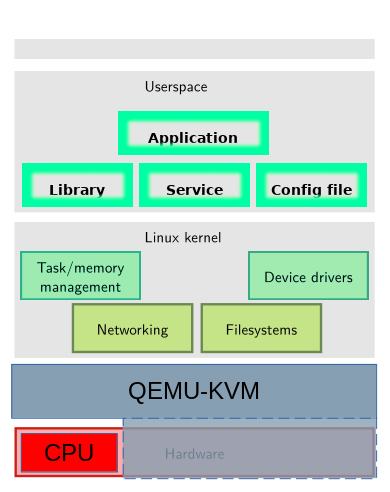
- QEMU user-mode emulation: User-space emulation, with system calls forwarded to the host kernel.
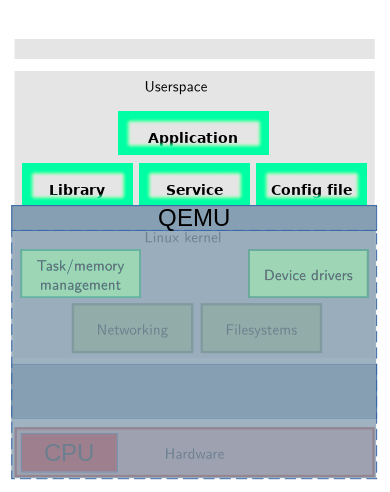
QEMU also allows debugging of the emulated system through its Gdbstub component, which exposes the GDB protocol. GDB (GNU Project Debugger) is a debugger that enables controlled execution of binaries on Linux. It provides Python APIs that allow for writing extensions, with popular ones being Peda, GEF, and pwndbg. In this case, we are particularly interested in GDB Multiarch, which enables remote debugging of a program compiled for a different CPU architecture than the host.
Gdb-multiarch + QEMU user-mode
With the help of GDB-multiarch and QEMU user-mode, it’s possible to monitor the emulation and execution of a program on the same host machine. To avoid reflecting system call operations on our filesystem, we use chroot, which allows us to change the root directory (“/”). We also use qemu-static, which, being statically compiled, doesn’t require external libraries.
CVE-2020-36109
The CVE-2020-36109 vulnerability is described as a buffer overflow within the blocking_request.cgi file/function, exposed by the httpd service. This could allow remote code execution. The disclosure date is 2021-01-04, which helps us identify the correct firmware version.

Firmware Extraction
Based on the CVE disclosure date, we download two firmware versions: an unpatched version and a patched version. We extract the unpatched firmware, which is in cleartext, using tools like binwalk and ubidump.

The blocking_request.cgi file is not present in the extracted filesystem, but by running grep -r blocking_request.cgi, we find the string in the httpd file. This indicates that the CGI file is implemented directly by the httpd service. The device architecture is ARM.

String Analysis
We open the unpatched httpd binary with the Ghidra decompiler. Since the service must respond to HTTP client requests, it should provide different responses based on the requested URI. For integrated CGI files, a function table is likely used, with each entry containing a pointer to a string for comparing the URI and a function to invoke if the comparison is successful. To reconstruct the function table and improve the decompiled output, we use the codatify script (Ghidra fix_code version).



We find the string "do_blocking_request_cgi", which leads us to function 0x48df4. We follow the same process for the patched firmware version and compare the two decompiled files. The patched version’s function is more accurate in terms of stack layout, so we rely on it for a closer representation of the source code. What stands out are multiple strlcpy calls in the patched version, related to fields like CName, mac, interval, and timestap. Additionally, there are more field validations, suggesting these fields are likely passed via the client’s HTTP request.

Binary Diffing
To better understand the modifications in the patched binary, we use bindiff, a tool that exposes techniques for binary diffing and highlights differences between two binaries in terms of assembly code and control flow graphs. To use bindiff with Ghidra, we generate the input using binexport (guide available here link).

Another method for identifying key differences is checking if new library functions were imported or if they are called more or fewer times in the patched version. We also provide a Python script that performs this task using radare2 link.

Emulation
We proceed with Gdb-multiarch + QEMU user-mode + chroot.

To expose the GDB stub on QEMU, we use the -g <port> flag and run the following commands in two separate terminals: sudo chroot ${PWD} ./qemu-arm-static -g 12345 bin/sh, sudo gdb-multiarch ./bin/busybox -q --nx -ex "source ./.gdbinit-gef.py" -ex "target remote 127.0.0.1:12345"

When launching httpd, several exceptions occur, so we trace system calls to fix the chrooted filesystem. We use the command: sudo chroot ${PWD} ./qemu-arm-static -strace -D logstrace.log ./usr/sbin/httpd. From the log, we extract the missing files, folders, symbolic links, and libraries and fix them.





Once the missing file issues are resolved, we also need to emulate the nvram part, as ASUS routers store and modify configurations in this memory. As noted in the strace log, nvram should be mounted at /jffs/nvram_war.
To communicate with nvram, libnvram is used, which provides several key functions:
| Function Name | Description |
|---|---|
nvram_init() |
Initializes the libnvram library. |
nvram_get(key) |
Retrieves the value associated with key. |
nvram_set(key, value) |
Sets the value for the specified key. |
nvram_unset(key) |
Removes the entry associated with key. |
nvram_save() |
Saves changes made to the NVRAM configuration. |
nvram_load() |
Loads the NVRAM configuration. |
nvram_list_all() |
Lists all entries in the NVRAM configuration. |
nvram_reset() |
Resets the NVRAM configuration to defaults. |
To address this, we use LD_PRELOAD hooking, cross-compiling the nvram-faker library.
Default key entries are taken from the nvram.ini file, which is generated from user leaks on forums (e.g., “nvram show” site:pastebin.com). We then run: sudo chroot <path-rootfs_ubifs> ./qemu-arm-static -E LD_PRELOAD=./libnvram-faker.so -g 12345 ./usr/sbin/httpd -p 12234 and sudo gdb-multiarch ./usr/sbin/httpd -q --nx -ex 'source ./.gdbinit-gef.py' -ex 'target remote 127.0.0.1:12345'.

At this point, we begin reverse engineering using the debugger. By setting breakpoints, especially on str* functions, we trace the binary’s control flow. Through this hybrid reverse engineering process, we gather the following notes:
0x018dccreads the request and performs initial parsing (HEAD section).
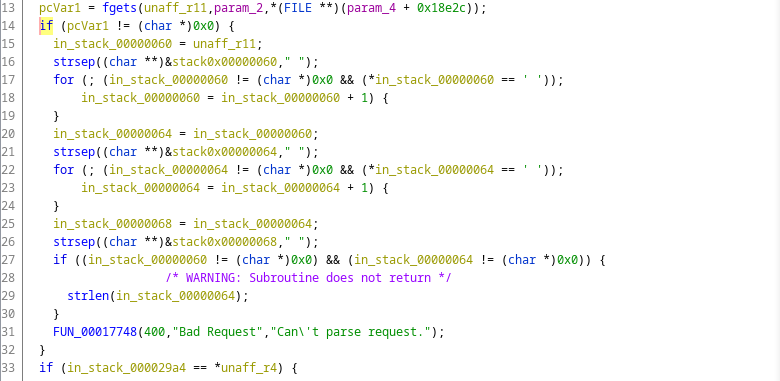
0x1b79cextracts the first argument from the POST request payload.0x1ccb0takes a string argument and returns the corresponding nvram value.- The POST request to
blocking_request.cgiis used to add MAC addresses to a blacklist, likely for LAN connections. - The fields
CName,mac,interval, andtimestapmust be passed in the POST request. - For the condition to pass, the request’s timestap field must be within 21 seconds of the router’s
timestamp, and themacfield must be a substring of the nvramMULTIFILTER_MAC.
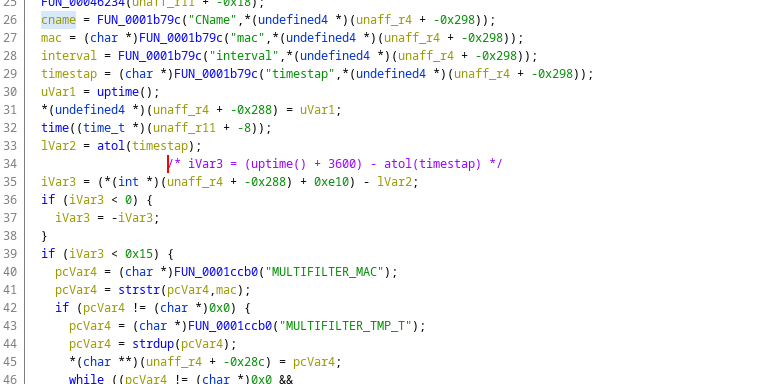
Exploitation
The vulnerability lies in the potential execution of two strcat functions into a fixed-size stack buffer, where the input is provided by the client through the POST parameters mac and timestap.

To trigger the vulnerability, we need to craft a request with the following characteristics:
- The
timestapparameter must be valid, as it is converted to an integer via theatolfunction. - The
macparameter must be a substring ofMULTIFILTER_MAC. Based on information found online, this value initially seems to be NULL (?), so assuming this is true, themacparameter should be set to%00. - The overflow can only occur through the
timestapparameter, but it must still be a valid value foratol. We resolve this by using the value"<valid-int>%0a<payload>".
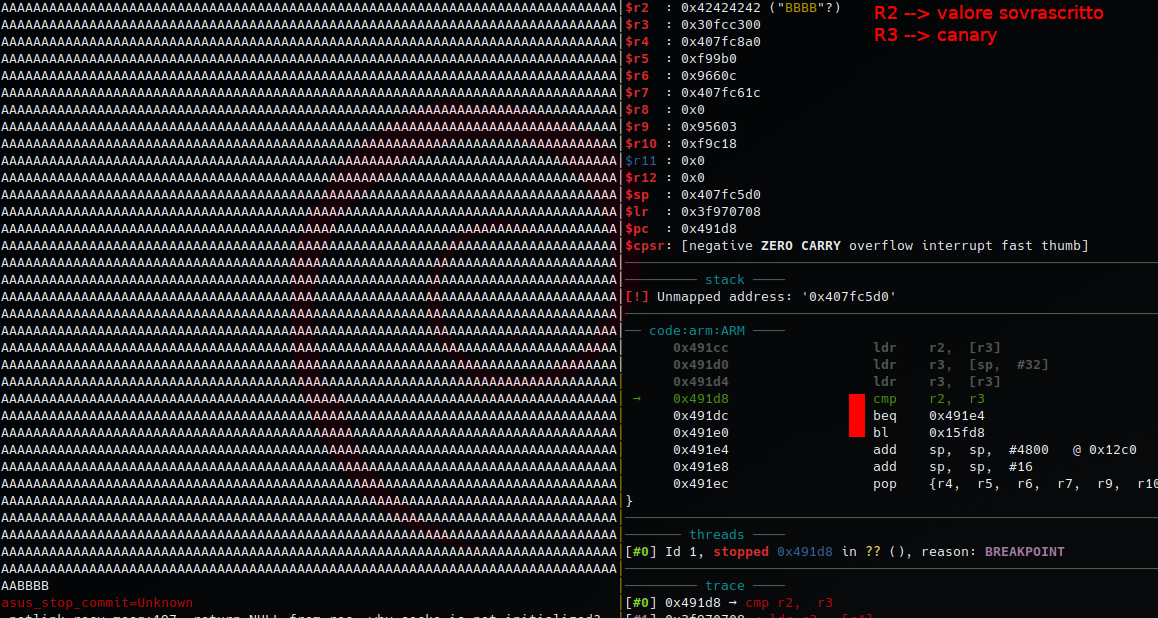

CVE-2020-36109 Considerations
The scripts for replicating the test environment and the PoC are provided at the following links:
Exploit Limitations:
- The overflow occurs via
str*functions, meaning null characters cannot be used in the payload. - The payload is located right below the stack’s epilogue, so we cannot corrupt any data structures other than the return address.
- There is a stack canary in place, and for the reasons mentioned above, even if we could somehow guess the canary value, if it contains a null byte, it becomes impossible to overwrite the return address.
- The stack canary contains a null byte.
Making the exploit work:
- If the
MULTIFILTER_MACnvram value contains any ASCII characters, this would allow us to overflow first with themacparameter and then with thetimestapparameter. Combining these, we could overwrite the return address and create a ROP (Return-Oriented Programming) chain. - ASUS routers run httpd as a daemon, meaning the process that handles the client request is a child of the parent process. This implies that it inherits the same address space, making brute-forcing the canary and base addresses for the ROP feasible.
Patch:
- As mentioned earlier, the patch restricts the size of the POST parameters using
strlcpy.
CVE-2023-35086
CVE-2023-35086 identifies a format string vulnerability in the following router models and versions: RT-AX56U V2: 3.0.0.4.386_50460 and RT-AC86U: 3.0.0.4_386_51529. The report indicates that the vulnerability exists in the do_detwan_cgi function of the httpd service. However, this vulnerability is also present in other ASUS router models.
By following the same steps outlined in the CVE-2020-36109 section, we are able to emulate part of the firmware. The string analysis reveals the location of the function that handles GET and POST requests to the /detwan.cgi URI, which is located at 0x49258.
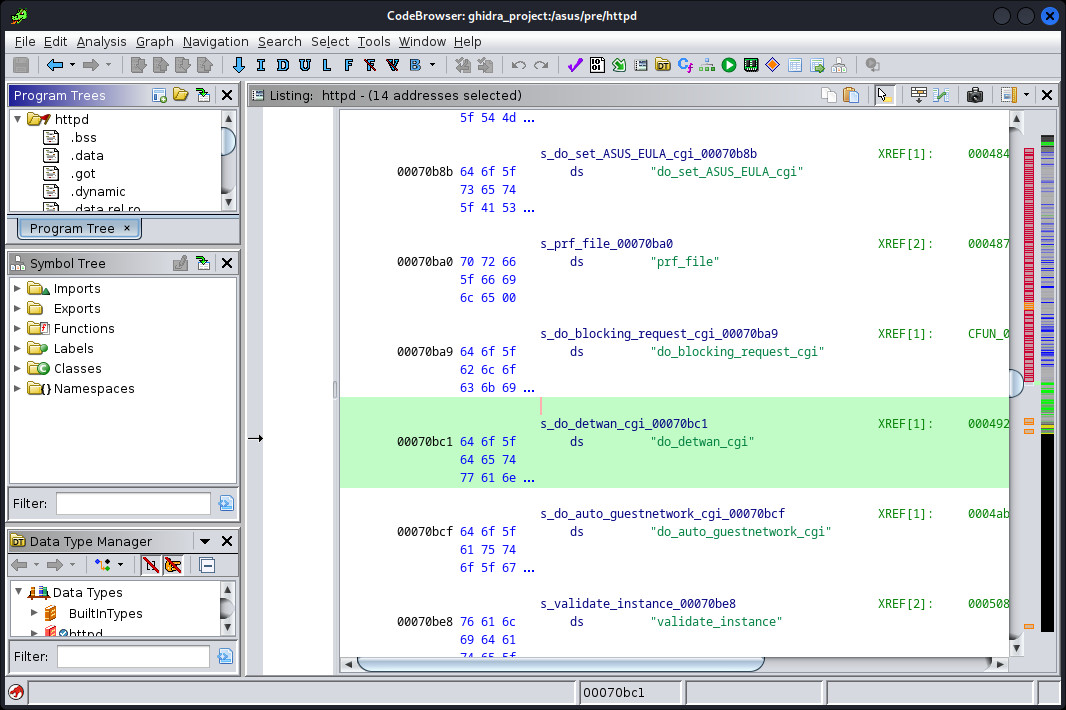
We attempt to decompile the function using Ghidra’s decompiler, which does not display the entire function but reveals the following key points:
FUN_0001b70cextracts theaction_modeparameter passed by the client.- The parameter is used as the third argument in the call to
logmessage_normal, which is an external function exposed by libshared.
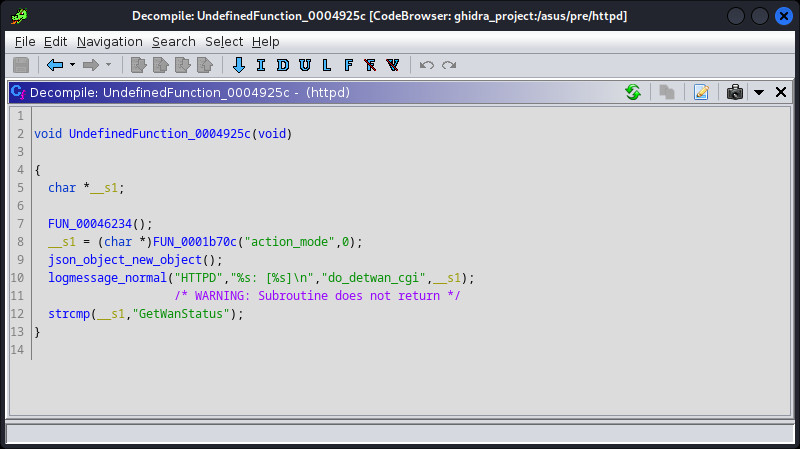
By searching on GitHub, we find that the source code for the logmessage_normal function is available in the asuswrt-merlin project, specifically in the file asuswrt-merlin/release/src/router/shared/misc.c. As we can see, the function saves the content of the action_mode HTTP parameter into the local variable buf, which is then used as the second argument in the syslog call.

As noted in the manual, the syslog function provided by libc supports format strings. Therefore, by passing a format string in the action_mode HTTP parameter, we can trigger this vulnerability.

To reproduce the PoC, run the following commands in two separate terminals: sudo chroot <path-rootfs_ubifs> ./qemu-arm-static -E LD_PRELOAD=./libnvram-faker.so -g 12345 ./usr/sbin/httpd -p 12234 and sudo gdb-multiarch ./usr/sbin/httpd -q --nx -ex 'source ./.gdbinit-gef.py' -ex 'target remote 127.0.0.1:12345'.
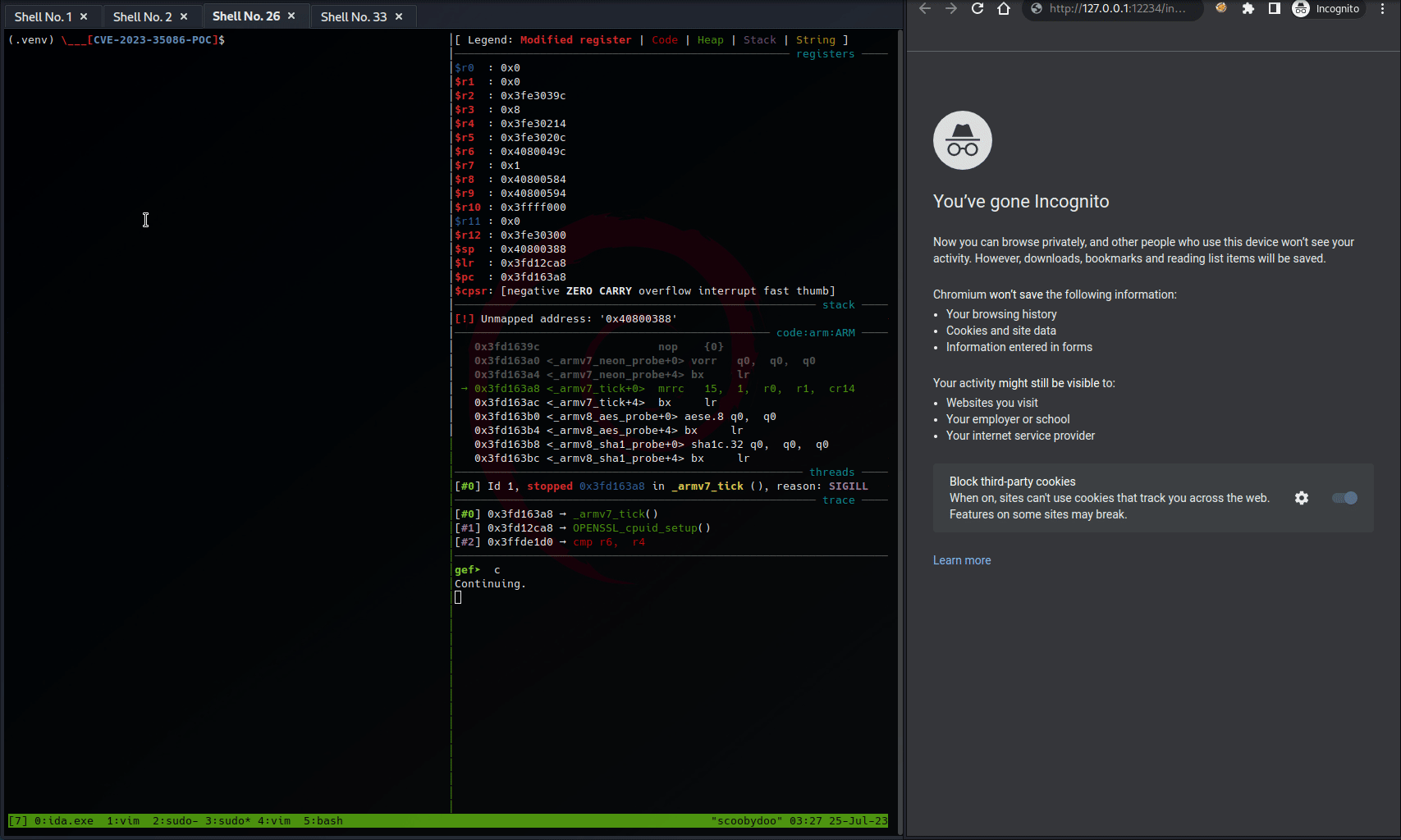
CVE-2023-35086 Considerations
The scripts to replicate the test environment and the PoC are provided at the following links: